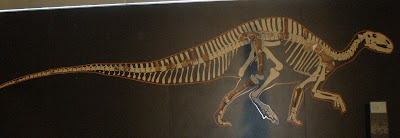The Location of Hateg Island 90 mio ago
Hateg Island existed from approximately 100 to 66 million years ago, though it may still have been present in the earliest Paleocene. It was surrounded by the Tethys ocean, which covered most of Europe at the time. There is some uncertainty concerning the size of the island, but current estimates put it at 80,000 square kilometers. It was quite geographically isolated, more than 200 kilometers from the nearest coasts, which to the north was the Bohemian Massif, and to the south an island corresponding to the Balkan massif, meaning that interaction with the outside world would be minimal for any animals not capable of flight. The climate of Hateg was sub-tropical, with marked dry and rainy seasons, and an average temperature in the twenties. Lot's of material for seeds and berries has been found in the Hateg sediments, as has pollen for Birch, Walnut and Beech, giving us a good idea of the island's forest structure.
Dry woodland similar to this would have covered much of Hateg Island
The most interesting part of Hateg, at least in my opinion, is however the fauna. While the initial animals from which the Hateg faunas descended from were probably quite typical for the time, the insular conditions caused them to develop in a very different direction from their mainland cousins. Much like the way Dwarf Elephants were once found on many islands, the terrestrial fauna of Hateg almost entirely consisted of island dwarfs. Probably the largest animal on the island was a Titanosaur named Magyarosaurus dacus, at 6 meters in length. Another large animal on the island was a Hadrosaur named Telmatosaurus, which could reach up to 5 meters. Both of these animals are still large compared to modern mammals, but downright tiny compared to their mainland counterparts, with some Titanosaurs being able to reach 30 meters. Other herbivores on Hateg included the Nodosaur Struthiosaurus and the two Rhabdodontids, Zalmoxes and Rhabdodon, with the later being particularly interesting in that it was also found on other European islands.
Wall mounted fossils of Rhabdodon
As with the herbivores, the Theropods of Hateg were also clearly insular species, with oddities such as Balaur bondoc, a possibly herbivorous dromeosaur-like flightless bird, Elopteryx, a nomen dubium known only from a few bones, probably from some form of Maniraptoran, Bradycneme draculae, an alvarezsaurid, and a Carnosaur who's relations are currently unknown. The apex predators of Hateg were not however Theropods, but rather members of another lineage of Archosaurs, the Pterosaurs. Hatzegopteryx thambema, a giant Azhdarchid, was by far the largest predator on the island, at around the size of a Giraffe. While probably unable to take down the adults of the larger herbivores, they would almost certainly have been deadly predators of juvenile animals and smaller species. Another species of Azhdarchid, Eurazdarcho, is also known from Hateg, along with a very peculiar short-necked genus that is currently unnamed.
Hatzegopteryx thambema by Mark Witton
In summary, Hateg Island really was a particularly odd and spectacular location, even by the standards of the Mesozoic. The concept of dwarf dinosaurs is a fascinating one, and with an island as large as Hateg, what we have is an entire ecosystem populated by them. Insular dwarfism is a familiar concept that we know occurs in modern animals, but Hateg Island played a key role in proving that these same evolutionary pressures also shaped dinosaurs and other prehistoric animals living on ancient islands. Our current knowledge of Hateg is still quite limited, and there are probably many more species waiting to be discovered, but even with our current understanding, what we find is an astounding lost world, unlike any other.





Very interesting read. Looking forward to the next post!
ReplyDelete